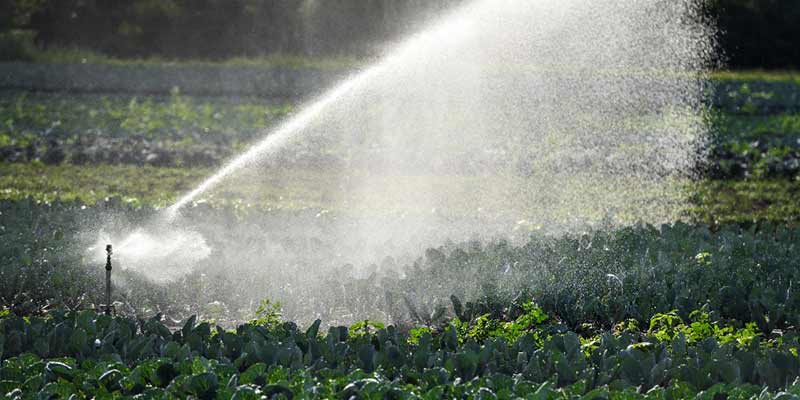- India
- Sep 24
- Mathew Gregory
Irrigated land in the country
Programs pertaining to irrigation of agricultural land are planned, funded, executed and maintained by the State Governments themselves as per their own resources and priorities. To supplement their efforts and to encourage sustainable development and efficient management of water resources, the Central Government provides technical and financial assistance to State Governments through various schemes and programs.
Pradhan Mantri Krishi Sinchayee Yojana
Pradhan Mantri Krishi Sinchayee Yojana (PMKSY) was launched during 2015-16, by Central Government with an overarching vision to ensure access to some means of protective irrigation for all agricultural farms in the country, and to produce ‘Per Drop More Crop’, thus bringing much desired rural prosperity.
In order to accord high priority to water conservation and its management, Government of India has formulated PMKSY with the vision of extending the coverage of irrigation ‘Har Khet ko pani’ and improving water use efficiency ‘More crop per drop' in a focused manner with end to end solution on source creation, distribution, management, field application and extension activities.
Objectives
• To achieve convergence of investments in irrigation at the field level
• To expand cultivable area under assured irrigation
• To improve on-farm water use efficiency to reduce wastage of water
• To enhance the adoption of precision-irrigation and other water saving technologies (More crop per drop)
• To enhance recharge of aquifers and introduce sustainable water conservation practices by exploring the feasibility of reusing treated municipal waste water for peri-urban agriculture and attract greater private investment in precision irrigation system.
Features
• There are four components of PMKSY are
1. Accelerated Irrigation Benefits Programme (AIBP)
a. To focus on faster completion of ongoing Major and Medium Irrigation including National Projects.
2. Har Khet Ko Pani (HKKP)
a. Creation of new water sources through Minor Irrigation (both surface and ground water)
b. Repair, restoration and renovation of water bodies; strengthening carrying capacity of traditional water sources, construction rain water harvesting structures (Jal Sanchay);
c. Command area development, strengthening and creation of distribution network from source to the farm;
d. Improvement in water management and distribution system for water bodies to take advantage of the available source which is not tapped to its fullest capacity (deriving benefits from low hanging fruits). At least 10% of the command area to be covered under micro/precision irrigation.
e. Diversion of water from source of different location where it is plenty to nearby water scarce areas, lift irrigation from water bodies/rivers at lower elevation to supplement requirements beyond IWMP and MGNREGS irrespective of irrigation command.
f. Creation and rejuvenation of traditional water storage systems like Jal Mandir (Gujarat); Khatri, Kuhl (H.P.); Zabo (Nagaland); Eri, Ooranis (T.N.); Dongs (Assam); Katas, Bandhas (Odisha and M.P.) etc. at feasible locations.
3. Per Drop More Crop
a. Programme management, preparation of State/District Irrigation Plan, approval of annual action plan, Monitoring etc.
b. Promoting efficient water conveyance and precision water application devices like drips, sprinklers, pivots, rain-guns in the farm (Jal Sinchan);
c. Topping up of input cost particularly under civil construction beyond permissible limit (40%), under MGNREGS for activities like lining inlet, outlet, silt traps, distribution system etc.
d. Construction of micro irrigation structures to supplement source creation activities including tube wells and dug wells (in areas where ground water is available and not under semi critical /critical /over exploited category of development) which are not supported under PMKSY (WR), PMKSY (Watershed) and MGNREGS.
e. Secondary storage structures at tail end of canal system to store water when available in abundance (rainy season) or from perennial sources like streams for use during dry periods through effective on-farm water management;
f. Water lifting devices like diesel/ electric/ solar pumpsets including water carriage pipes.
g. Extension activities for promotion of scientific moisture conservation and agronomic measures including cropping alignment to maximise use of available water including rainfall and minimise irrigation requirement (Jal sarankchan);
h. Capacity building, training for encouraging potential use water source through technological, agronomic and management practices including community irrigation.
i. Awareness campaign on water saving technologies, practices, programmes etc., organisation of workshops, conferences, publication of booklets, pamphlets, success stories, documentary, advertisements etc.
j. Improved/innovative distribution system like pipe and box outlet system with controlled outlet and other activities of enhancing water use efficiency.
4. Watershed Development
a. Water harvesting structures such as check dams, nala bund, farm ponds, tanks etc.
b. Capacity building, entry point activities, ridge area treatment, drainage line treatment, soil and moisture conservation, nursery raising, afforestation, horticulture, pasture development, livelihood activities for the asset-less persons and production system & micro enterprises for small and marginal farmers etc.
c. Effective rainfall management like field bunding, contour bunding/trenching, staggered trenching, land levelling, mulching etc.
• Focus is on creating sources for assured irrigation
• Also creating protective irrigation by harnessing rain water at micro level through ‘Jal Sanchay’ and ‘Jal Sinchan’.
• It adopts State level planning and projected execution that allow States to draw up their own irrigation development based on District Irrigation Plans and State Irrigation Plans.
• Funding arrangement for both the Central & State share has been approved through NABARD under Long Term Irrigation Fund.
(The author is a trainer for Civil Services aspirants. The views expressed here are personal.)

